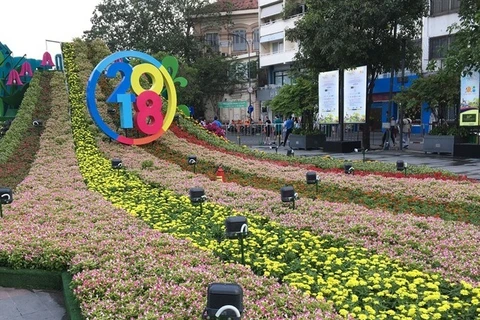Hanoi (VNA) - Rich or poor, Vietnamese at home or abroad carefully cook traditional dishes to put on the home altar to worship their ancestors during Tet (Lunar New Year) festival.
At Tet, each ethnic group has its own culinary specialties that reflect the culture of their people. Most Kinh (Vietnamese ethnic majority) people start preparations a month before the festival.
Many people usually cook nine dishes: banh chung (square sticky rice cake), dua hanh (pickled onions), gio nac (boiled lean pork sausage) and gio thu (boiled pork head sausage), thit dong (frozen meat), nem ran (spring rolls), canh mang ( bamboo shoot soup), canh bong tha (dried pig skin soup), boiled chicken, and che kho (sweet green bean paste).
Of all the dishes, banh chung is the soul of Tet, reflecting the quintessence of heaven and earth through the skilled hands of humans. My mother had to invest much time and effort to make the cakes. She had to choose the most fragrant and fibrous sticky rice to make a cake that can last for a month. They often had pork, green beans, dried onions and pepper in the centre.
I remember my mother wrapping the cake like a professional. In two hours, she would wrap 30 big square cakes (1.5kg each), which she asked us to line them up in a big pan for almost 14 hours. “Your mother’s banh chung are the most tasty and they are much bigger than others,” said one of my neighbours.
The cakes are often eaten with dưa hành (pickled onion) because its sour and light peppery flavour helps digestion. Meanwhile, gio nac and gio thu have remained on the offering food tray at Tet from the past to the present.
Culinary expert Nguyen Anh Tuyet said for Vietnamese, a plate of these foods had played an important role in turning traditional offerings into delicacies.
Thit dong (frozen meat) of pork or chicken is a particular Tet dish for northerners.
Tuyet said the dish was easy to cook. Ingredients included bacon or chicken plus 0.2kg of pig skin. All are cut into small rectangles (two fingers) then stewed slowly for an hour and then let cool before putting in a fridge.
“In the past, few people had a fridge, so I often put a pot of thit dong on the ground outside for the night during the winter. The cold froze the food, which was served with pickled onions,” said Tuyet. "One never forgets its taste."
Nem (spring rolls) is a popular dish in the north that always has a place on a Tet food tray because it is so flavourful and healthy. It is made out of minced pork, carrots, wood ear fungus, green-bean sprouts, bean glass noodles and other ingredients. The fried rolls are then dipped into a bowl of sauce of mixed fish sauce, sugar, lemon or vinegar, chili and minced garlic.
The Tet food tray of northerners never lacks a big bowl of canh mang kho (dried bamboo shoot soup). Tuyet said the soup could be eaten throughout the Tet holiday. “Canh mang with rice vermicelli or noodles helps always is a winner,” she said.
Canh bong thap cam (Assorted dried pig skin soup) is a Hanoi delicacy made from kohlrabi, carrots, peas, shrimp, pork tenderloin, and lean pork paste. “It is a dainty dish. Hanoians often cut the carrots into flower shapes, scoop the pork paste into balls and slice the fried eggs into thin threads. They add it to the chicken broth with dried skin pig (similar to dried fish bladder),” said Tuyet.
The last two dishes on the tray are boiled chicken and che kho (sweet green bean paste). People believe the boiled chicken offered to heaven in spring will bring advantages and happiness year round. Yellow-chicken meat covered with sliced lemon leaves is dipped in a bowl of salt, lemon, chili and pepper. “It is more enjoyable when eating a 1.3-1.4kg free range chicken raised by small farmers,” said Tuyet.
Che kho is another popular dish with Hanoians. The dish is made of green beans, white sesame and sugar. Elderly people say the dish brings children good luck at studies and good health for themselves. “The dish exudes the special fragrance of green beans and has the buttery taste of white sesame. It melts in your mouth,” Tuyet said.
Ethnic groups, such as the Mong, Thai, Muong, Tay, Nung, Dao, and Co Tu, have their own New Year dishes.
Culinary expert Le Kim Chi said for the Mong, their Tet tray should include dishes such as pork, wine, round cakes made from glutinous rice and maize cakes.
Fried fish is the specific dish of the Thai. They believe the stream deity will protect them from danger.
Chi said the Nung group often made banh khao from dried glutinous rice powder, minced pork fat and sugar to worship their ancestors. The elderly said the sweet fat in the cake would prevent unlucky happenings in the New Year.
Meanwhile, the Co Tu in Tay Nguyen (the Central Highlands) make their own wine known as ruou Ta Vat and ruou can to welcome Tet. All visitors at New Year are invited to enjoy these wines.
Each Dao household has its own thit lon chua (sour pork), locally known as o sui, in New Year holidays. Ingredients include pork, salt, and cool rice. The dish should be eaten with la lot (wild lolot leaves) and la prang lau (a kind of wild leaf), and dipped in a bowl of mixed lemon and chili.
The Tay welcome Lunar New Year with a roast piglet. They often choose local piglets with small bones, firm and lean meat weighing from 20kg to 30kg. People often put mac mat (a kind of wild leaf and fruit) mixed with spices in the pig’s belly and cover the skin with honey. They then roast it on charcoal for three hours until well done. The food is dipped in a sweet and fragrant sauce gotten from the pig’s belly.
One Tay elder, Nong Van Coong, said in the past rich people often offered an entire roast piglet on their altar, while the poor used only the head.
Coong said this tradition had existed for hundreds of years because his people believed the pig offering brings them a bumper harvest and good life in the New Year.-VNA
VNA




























